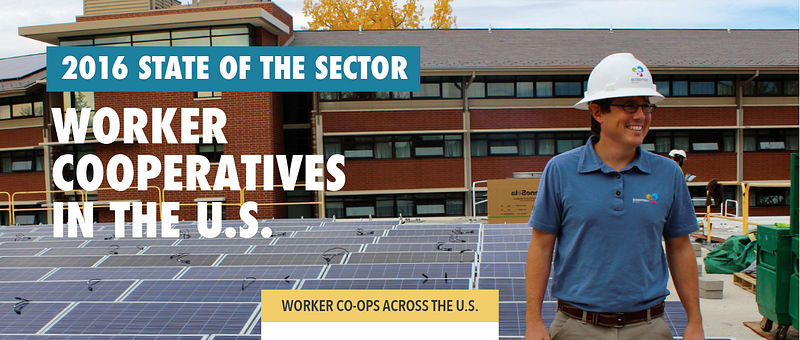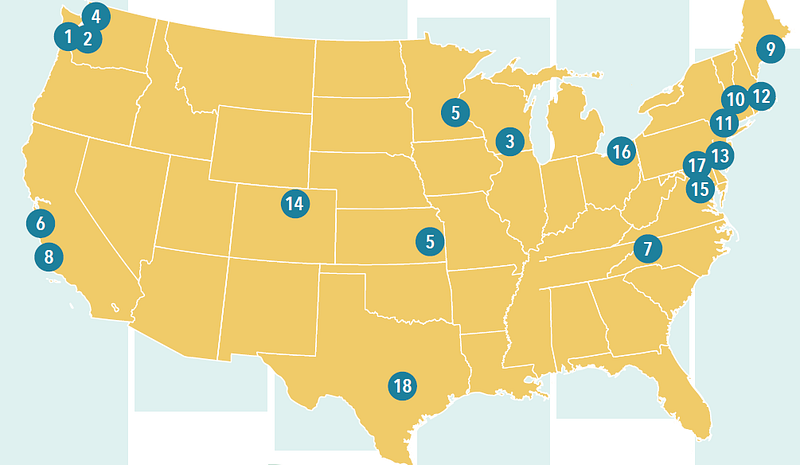National survey shows small but steady growth of U.S. worker cooperatives
by Karen Kahn

A new report from the Democracy at Work Institute (DAWI) and the U.S. Federation of Worker Cooperatives estimates that 357 worker cooperatives operated in the United States in 2016. These businesses employed 6,833 people and generated $428 million in gross revenues in 2016.[i]
As the numbers suggest, worker cooperatives remain marginal in the U.S. economy. In 2016, the year of the survey, 15 new cooperatives were started, and 11 conventional businesses converted to worker ownership, growing the sector by 2.4 percent (a higher rate than the U.S. economy, which grew by 1.6 percent in 2016). Tim Palmer, research director for DAWI, says, though the growth rate isn’t huge, we have seen consistent growth since we began the surveys four years ago. Notably, he says, “Not a lot of these businesses are closing. From the data we’ve collected, we think that cooperatives may be more resilient than other small businesses.”
From the data we’ve collected, we think that cooperatives may be more resilient than other small businesses.
— Tim Palmer, DAWI Director of Research
Fifty by Fifty and its partners see great opportunity for converting more businesses to employee ownership, including worker cooperatives, particularly as baby boomers who own local businesses look to retirement. The DAWI survey found in 2016 one in four operating cooperatives (23 percent) converted from a conventional business, while 70 percent began as startups. Of these, 14 percent were incubated by cooperative developers. The data on the engagement of cooperative developers was new in this year’s survey, and “provides a baseline to see the impact of this kind of technical assistance over time,” says Palmer.
As democratic workplaces, worker cooperatives give workers the opportunity to share in both governance and the wealth created by their businesses. With average revenues of nearly $4 million and profits of $150,000 each year, the cooperatives distribute, on average, nearly $19,000 in profit — referred to as patronage in cooperative accounting — to their members. Profit-sharing in the form of these patronage distributions provides a substantial supplement to hourly wages.

The DAWI survey also maps the regional distribution of worker coops, finding the most active hubs on the East Coast. On the West Coast, the Northwest has a strong hub between Seattle, Portland, and Olympia, and in San Francisco, which hosts 50 worker cooperatives. Worker cooperatives exist in almost all industries, with the highest concentration in Retail Trade (16 percent), Professional, Scientific, and Technical Services (16 percent), and Waste Management Remediation Services (13 percent), followed by Manufacturing (11 percent) and Accommodation and Food Service (9 percent). Palmer notes that “coops are far more diverse than people think; the difference in concentration in the top five sectors is pretty small, and that hasn’t really changed since we began doing surveys.”
Notably, the worker cooperative workforce is 63 percent people of color, a number that has increased in recent years. Cooperative Home Care Associatesremains the nation’s largest worker-owned cooperative, with over 2000 employees, almost entirely women of color, providing home health services to New Yorkers who are aging, chronically ill, or living with disabilities. Other worker cooperatives where employee-owners are primarily people of color include the Evergreen Cooperatives in Cleveland, which now employ over 200-plus workers, Home Care Associates of Philadelphia, and Home Green Home Cleaning Co-op Network in the San Francisco Bay Area.
[i] Worker cooperatives are owned and governed by their employee-owners. At a minimum, employees vote for board members on a one-worker-one-vote basis; in some cases, they also participate in management. Profits are distributed to the employees based on hours worked, comparative salary, or another formula that reflects the employees’ contribution to the company through their labor.
